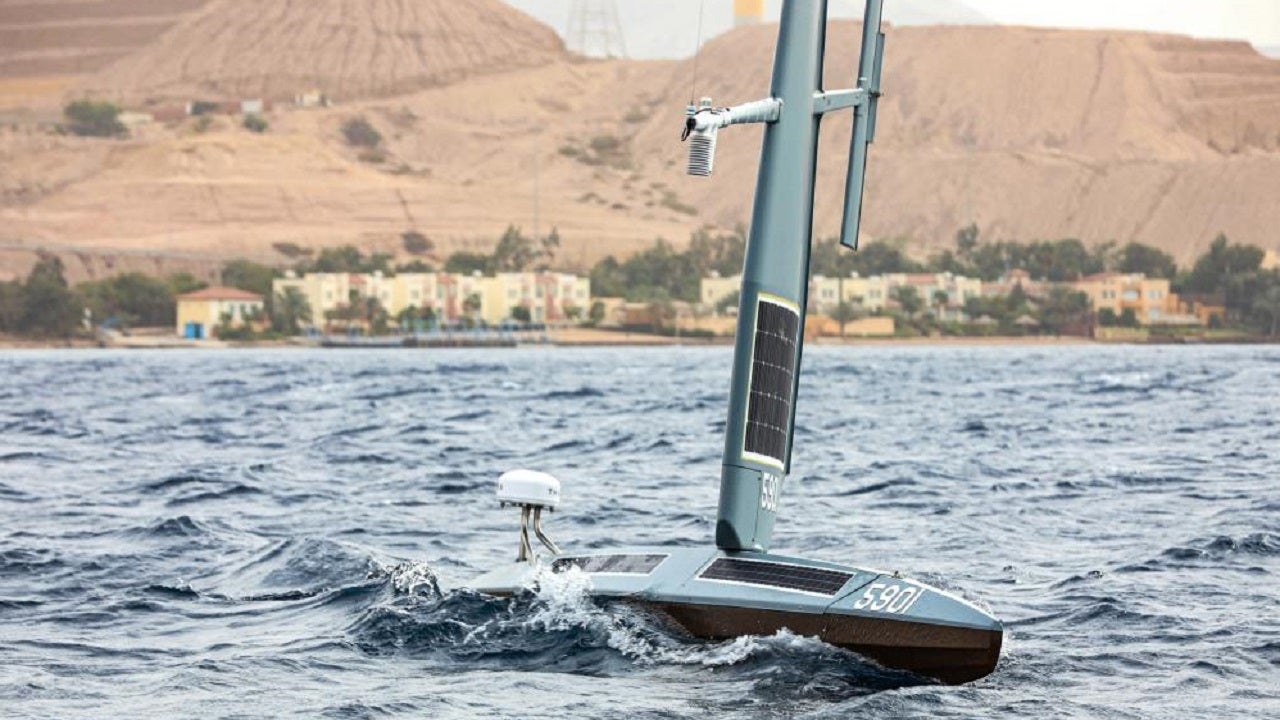The Iranian Navy recently captured two Saildrone Explorer unmanned surface vessels (USVs) in the Red Sea before releasing them on September 2. This development comes just days after the Islamic Revolutionary Guard Corps Navy attempted to seize one Saildrone Explorer in the Persian Gulf.
The incident reportedly occurred on September 1 when the Iranian Navy ship was seen pulling two US drones out of the water “in an attempt to steal them.”
Soon, the United States intervened with two nearby destroyers, the USS Nitze and USS Delbert D Black, and two helicopters. The US warships sought the release of drones over radio communication, which the Iranian Navy eventually did on September 2.
Iranian state television first aired footage it said was taken on the deck of the warship Jamaran of the Iranian Navy. The crew members could be seen moving the two Sailrone unmanned surface vessels (USVs) of the 5th Fleet of the United States Navy off the ship and into the water.
The Iranian Navy Jamaran's frigate yesterday seized two Saildrone USVs (unmanned vessels) in the Red Sea yesterday for allegedly endangering safe navigation. The USVs were released after US forces were cautioned, per Iranian state TV. Footage about 20 seconds in. pic.twitter.com/Su4PqKewCJ
— Kian Sharifi (@KianSharifi) September 2, 2022
In the state-affiliated broadcast, Iran had justified the capture by asserting that the Saildrone threatened the region’s safe navigation. Interestingly, the Iranian program by the Associated Press reported that “several unmanned spying vessels” had been “abandoned in the international maritime routes.”
“After two warnings to an American destroyer to prevent possible incidents, Jamaran seized the two vessels,” the Iranian state TV broadcast claimed. “After securing the international shipping waterway, the Naval Squadron No. 84 released the vessels in a safe area.”
It added: “The US Navy was warned to avoid repeating similar incidents in future.” The drones were identified as Saildrone Explorers by the US Navy’s 5th Fleet. Saildrone Explorers drones are offered for sale and are utilized by a range of customers, including scientists, to keep an eye on open waterways.
“The unmanned surface vessels were unarmed and taking unclassified photos of the surrounding environment while loitering in an assigned patrol area at least four nautical miles from the nearest maritime traffic lane,” the 5th Fleet said.

“The vessels posed no risk to naval traffic and had been operating in the general vicinity of the Southern Red Sea for more than 200 consecutive days without incident,” the US Navy added.
A US official told the Associated Press that the Iranian sailors initially attempted to conceal the drones with tarps and denied holding them. This marked the second such event recently as discussions over Tehran’s nuclear deal with major powers are still very much in play.
The earlier incident, which happened on August 29, took place in the Persian Gulf and included Iran’s paramilitary Revolutionary Guard. The Guard hauled a Saildrone Explorer before being released as an American warship followed it.
The unmanned Task Force 59 was launched by the 5th Fleet in 2021. The Navy employs a variety of drones, including long-range aerial surveillance drones, torpedo-shaped underwater drones, and surface vessels like the Sea Hawk and the Sea Hunter.
The jurisdiction of the Fifth Fleet includes the strategic Strait of Hormuz, the Persian Gulf’s narrow entrance through which 20% of the world’s oil passes. It extends to the Red Sea, close to the Suez Canal, the Egyptian waterway connecting to the Mediterranean, and the Bab el-Mandeb Strait, off Yemen.
Maritime Attacks In The Region
It’s important to note that all of this occurred in the Red Sea. Due to the complex web of tensions involving the United States, Iran, Saudi Arabia, Yemen’s Houthi rebels, and Israel, the area has recently been the site of many ship attacks.
Amid Yemen’s war, Houthi rebels have regularly deployed mines and bomb-laden drone boats into the Red Sea, damaging ships. Iranian soldiers have also caused problems by capturing oil tankers close to the United Arab Emirates and the Strait of Hormuz.
These attacks mainly started to occur nearly a year after then-President Donald Trump abruptly withdrew from Iran’s nuclear deal, in which sanctions were eased in exchange for Tehran severely restricting its uranium enrichment.
The Biden administration has committed to resurrecting the nuclear deal, arguing that it is the best way to prevent Iran from acquiring a nuclear weapon.
One of the grounds given by the Trump administration for withdrawing in 2018 was that the agreement did not prevent Iran’s support for proxy groups across the Middle East. In recent weeks, the United States carried out an airstrike on targets in Syria associated with Iran’s Revolutionary Guard Corps.
- Contact the author at ashishmichel@gmail.com
- Follow EurAsian Times on Google News